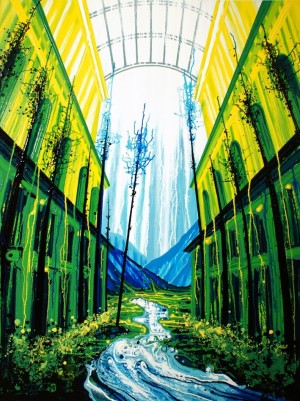Playing With Gravity: One Artist’s Newfound Trademark
The importance of gravity is redefined in a Toronto-based artist’s beautifully illustrated and sustainable world, explored through rich colors, patterns and incredible detail, all applied in a unique manner simplistically created though the manipulation of paint. Luminous yellows, forestry greens, and wintry, arid blues amalgamate into a fantastical perception of the biosphere, bringing a newfound life and wonderment to nature’s spectacles. It is as if stepping into a fragment of a Claude Monet painting from the late 1880s to early 1900s, after his cataract operations, full of intense colors and plays on light, or entering into an undiscovered region of the magical world of Narnia – never knowing what you will find lurking beneath the moss covered tree trunks.
She may be only 25, but Amy Shackleton’s impeccably brilliant landscapes and outlandish technique demonstrate experience well beyond her years — and she is transparently aware of her extraordinary accomplishments. “In a word, amazing,” she says, describing her faculty and style with a cinch of disbelief and modesty admixed with certain proudness; a clear admission of gratitude for not only possessing such a gift but for the success and admiration for her work that has emitted from it. Having exhibited her paintings in prominent cities like New York, London, Toronto, Montreal and Calgary, the young artist is adamant in her belief that she must continue nurturing her original talent, letting it transform and grow with her age in order to make a difference in the constantly evolving art world of the present day.
Though hardly a household name, Shackleton, after gaining international exposure through a YouTube video documenting her refreshingly original technique, has already managed to create quite a reputation for herself. “I appeared in The Huffington Post, New York Magazine, CBC and CBS, Gizmodo, My Modern Metropolis and Oddity Central,” she explains. “I sold paintings and made connections with people I wouldn’t normally be able to reach. It is great to know there are hundreds of thousands of people out there who appreciate my unique process, love what I am doing, and wish they could view my paintings in person. And, above all, it’s refreshing to realize that, maybe, I discovered something unique; something that no one has ever done before.”
And, in fact, it was in Shackleton’s unique ability in being able to create and push beyond the boundaries of conventional artistic tools that she found that she was equipped to experiment and hone her exquisite craft. In large part due to her innovative imagination, since September 2011 she has not used a paintbrush when working on her pieces. Rather than applying brisk layers of paint across a clean canvas in perfectly even strokes, the Canadian artist initiated her own revolution. Shackleton uses a dripping technique that is commonly seen amongst the work of abstract artists, applying paint to canvas by giving the bottle a gentle squeeze and letting its color slowly drip as she gradually rotates the painting, producing a watery effect.
But her process is not as simplistic as staggering paint across a canvas and rotating it like an abstract artist would. Each piece takes between 25 to 45 hours to make. Her recent series spanned about 250 hours of arduous labor.
“My technique has definitely evolved over the years,” she says. “I first learned how to paint with paintbrushes. It sure was not easy to stop using the tool I was most comfortable with, but you have to take risks to discover new things.”
Over the years, Shackleton’s method has survived and revived despite the unconventional element that surrounds it. According to the long-haired, dirty-blonde artist with natural, wavy light-brown highlights and rosy cheeks, it was not until she was willing to take a risk and eliminate the paintbrush that she discovered something equally unusual and incredible. And though the technique was nothing essentially new to the art world, it was novel to her as well as to her specific area of work, presenting her with an uncanny opportunity to break past the realm of gravity and the norm. What manifested was a canvas overflowing with realism with a slant.
“I started using squeeze bottles a few years ago to achieve a more natural and organic energy in my work,” she says. “I often used brushes for more precise, finishing touches. Eventually, in my mind, the brush became an unnecessary touch-up tool.”
Painting a utopian scene from photographs she took, she transforms current buildings into a sustainable future. Though the paintings are a stretch from the initial prints, subtle traces of the places remain in her work; an aftermath of careful planning and calculating that precedents every piece she paints.
“It took me over three years to master the technique. I am now able to create hard-edge details and curved lines with gravity. Each piece is a new adventure and I am always exploring new techniques,” she states. Able to defy the common misconception that art is a meticulous practice requiring fine lines and immediate structure, Shackleton emphasizes that though her work requires thorough preparation there is much left to chance and trial and error; an endeavor that she greatly enjoys. But as with all artists, reaching this end did not come without its efforts.
Shackleton spent countless hours of consideration before imitating her thoughts on canvas. It was through a technique she acquired after graduating from York University with a degree in Fine Arts that she began utilizing gravity assistance. Recently, she developed a rotating-easel device to help her in rotating the canvas; a task that she had to do manually beforehand which created an array of complications. Looking back, Shackleton admits that it was not always easy trying something different, and it required tremendous determination and drive on her part.
(Article continued on next page)











